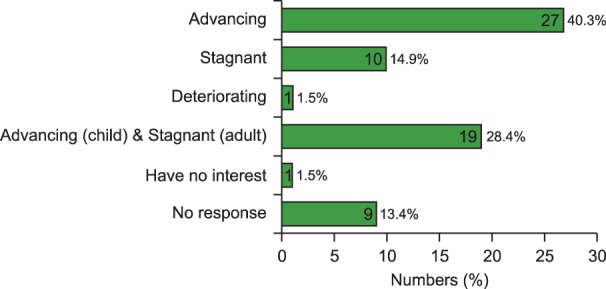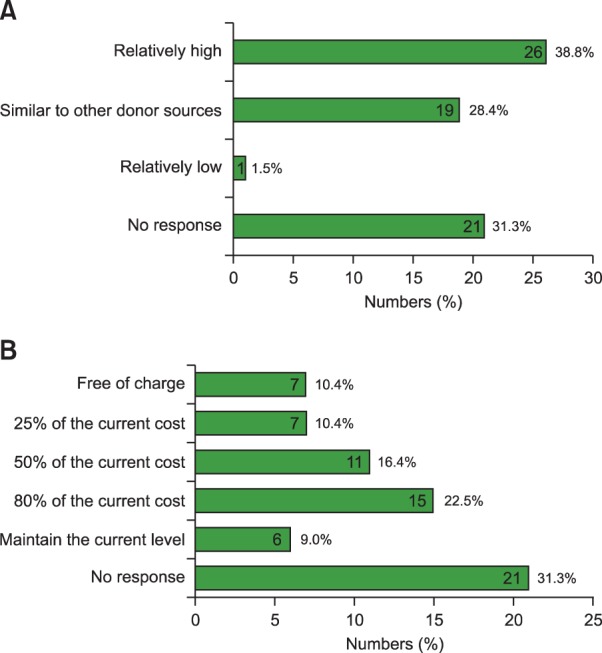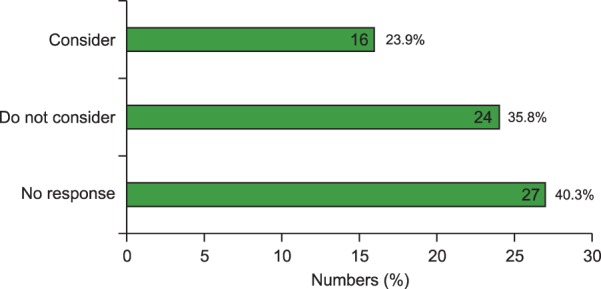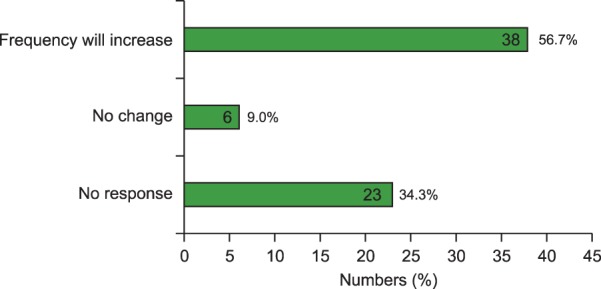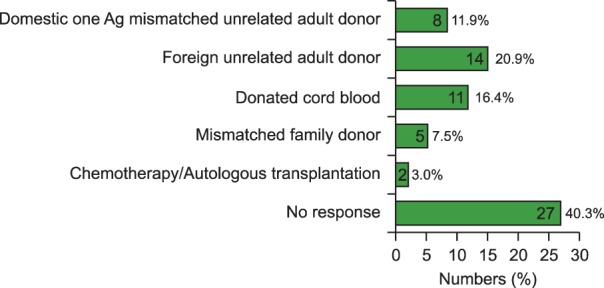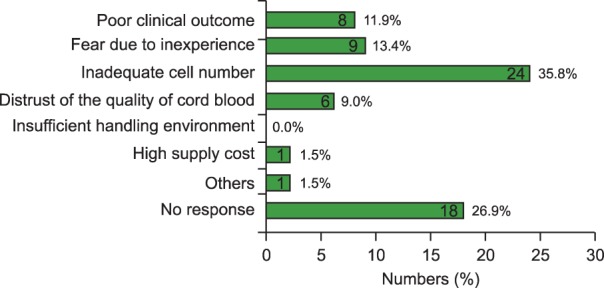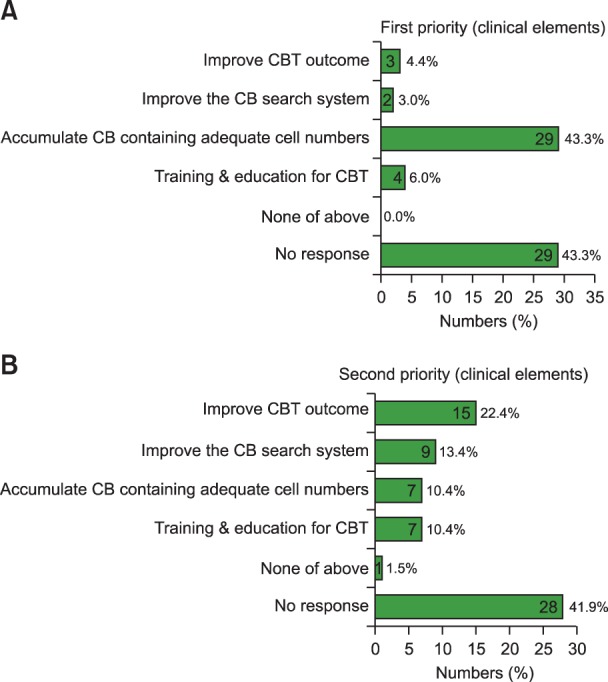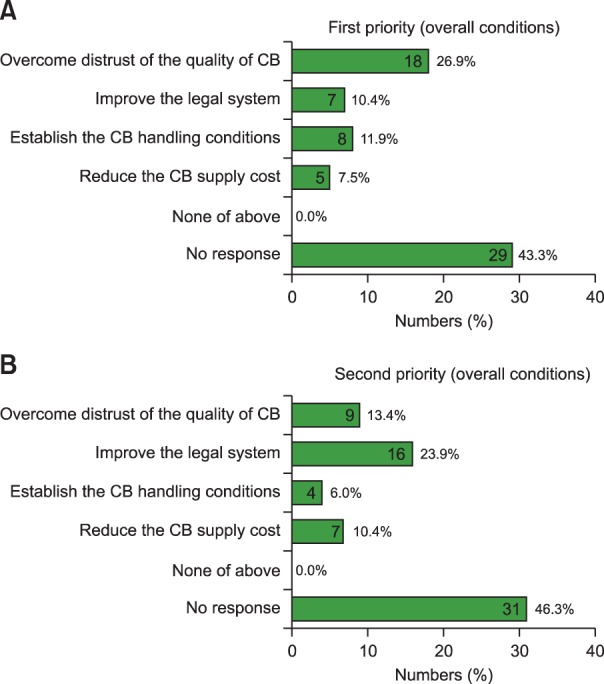Blood Res.
2014 Dec;49(4):228-233. 10.5045/br.2014.49.4.228.
Transplant physicians' perceptions of cord blood transplantation in Korea: a questionnaire survey
- Affiliations
-
- 1Department of Pediatrics, Hanyang University Medical Center, Seoul, Korea. cord@hanyang.ac.kr
- 2Department of Internal Medicine, Ewha Woman's University School of Medicine, Seoul, Korea.
- 3Department of Pediatrics, Keimyung University Dongsan Medical Center, Daegu, Korea.
- KMID: 2270679
- DOI: http://doi.org/10.5045/br.2014.49.4.228
Abstract
- BACKGROUND
Although bone marrow (BM) or mobilized peripheral blood (PB) is frequently used as the source of hematopoietic stem cells, hematopoietic stem cell transplantation (HSCT) using cord blood (CB) is gradually gaining popularity in many countries. However, BM or PB is still preferred over CB in Korea. Therefore, we tried to assess the awareness of CB transplantation (CBT) among domestic HSCT physicians and develop strategies for boosting its utilization by administering questionnaires to some of these physicians.
METHODS
A direct questionnaire survey was conducted using the "Audience Response System" among 301 members who attended the annual meeting of the Korean Society of Blood and Marrow Transplantation. The data were analyzed for only 67 board certified physicians who were directly involved in HSCT activities.
RESULTS
The poor outcomes resulting from insufficient experience in CBT was designated by the physicians as the main reason for the low domestic implementation of HSCT using CB. Other reasons identified in the survey were distrust in the quality and management of domestic CB and the high cost of obtaining CB.
CONCLUSION
Increasing the use of donated CB would foremost require increasing the inventory of donated CB containing a sufficient cell number for CBT and securing structured quality control of the CB banks. In addition, it would be necessary to minimize CB supply costs and continue to provide academic data, including CBT guidelines, so that clinicians could perform CBT with more confidence.
Keyword
MeSH Terms
Figure
Reference
-
1. Ballen KK, Gluckman E, Broxmeyer HE. Umbilical cord blood transplantation: the first 25 years and beyond. Blood. 2013; 122:491–498. PMID: 23673863.
Article2. Lee YH, Cho NC, Je KH, et al. Successful sibling cord blood stem cell transplantation for relapsed acute mixed lineage leukemic. Korean J Hematol. 1999; 34:471–476.3. Status of storage and transplantation of cord blood and an itemized account of patient's charges using cord blood. Seoul, Korea: Korea Marrow Donor Program;2014. Accessed June 5, 2014. at http://www.kmdp.or.kr.4. Annual and cumulative incidence of unrelated hematopoietic stem cell transplantation according to the stem cell sources. Tokyo, Japan: Japan Marrow Donor Program;2012. Accessed June 5, 2014. at http://www.jmdp.or.jp/documents/file/07_about_us/press/press_12_08_29.pdf.5. Growth of the cord blood registry. Minneapolis, MN: National Marrow Donor Program;2013. Accessed June 5, 2014. at https://bethematchclinical.org/Transplant-Therapy-and-Donor-Matching/Donor-or-Cord-Blood-Search-Process/Likelihood-of-Finding-a-Match/.6. Transplants by cell source, 1990-2013. Minneapolis, MN: National Marrow Donor Program;2013. Accessed June 5, 2014. at https://bethematchclinical.org/Transplant-Therapy-and-Donor-Matching/Cell-Sources/.7. Cord blood banking introduction-State of the art. Monaco: The World Marrow Donor Association;2013. Accessed June 5, 2014. at http://www.esh.org/wp-content/uploads/2013/11/Session-VState-of-the-art.pptx-Lecture-seule.pdf.8. Barker JN, Scaradavou A, Stevens CE. Combined effect of total nucleated cell dose and HLA match on transplantation outcome in 1061 cord blood recipients with hematologic malignancies. Blood. 2010; 115:1843–1849. PMID: 20029048.
Article9. Lee YH, Kwon YH, Hwang K, et al. Analysis of stored and transplanted cord blood units from KoreaCORD: reappraisal of banking guidelines and selection strategy. Transfusion. 2013; 53:123–127. PMID: 22612248.
Article10. Yoo KH, Lee SH, Sung KW, et al. Current status of pediatric umbilical cord blood transplantation in Korea: a multicenter retrospective analysis of 236 cases. Am J Hematol. 2011; 86:12–17. PMID: 21064135.
Article11. The law for cord blood management and research. Seoul, Korea: Ministry of Health & Welfare;2011. Accessed June 5, 2014. at http://www.mw.go.kr/front_new/index.jsp.12. Information system for searching unrelated hematopoietic stem cell donors. Cheongju, Korea: Comprehensive Management System for Disease and Health;2013. Accessed June 5, 2014. at http://is.cdc.go.kr/.
- Full Text Links
- Actions
-
Cited
- CITED
-
- Close
- Share
- Similar articles
-
- Umbilical Cord Blood Transplantation
- The immunobiology of cord blood transplantation
- Enactment of a Law for Governmental Support of the Use of Cord Blood, and Ethical Issues
- Impact of the COVID-19 Pandemic on Public Cord Blood Banks in Korea
- Mixed Mononuclear Cell Culture of Cord Blood and Adult Peripheral Blood

